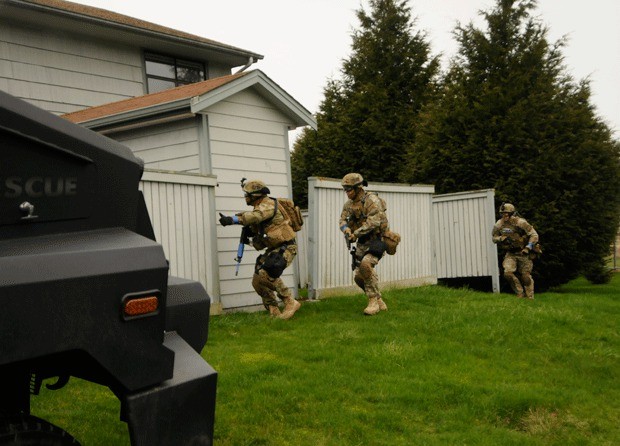Starting Tuesday, unauthorized people may attempt to enter Whidbey Island Naval Air Station, and the Navy is planning to be ready for them.
The Navy’s annual Solid Curtain/Citadel Shield, conducted at NAS Whidbey Feb. 18-28, is a series of readiness exercises conducted at Navy bases across the United States.
The exercises are designed to ensure that the base is ready to respond to threats.
“These events occur simultaneously and will stress different areas of the Navy’s anti-terrorism program to enhance the readiness of Naval Security Force personnel to respond to real-world threats,” said Mike Welding, NAS Whidbey Island public affairs officer.
While the exercises are expected to have minimal effect on the civilian population, there may be times when the exercise causes increased traffic around bases or delays in base access.
Area residents may see or hear increased security activity associated with the exercise, according to a news release issued by the base.
“We have planned the exercises so as not to impact peak traffic periods and should only cause minimal impacts to the community,” Welding said. “However, throughout the exercise period we will respond to scenarios that may drive us to alter the security posture, including temporary closures of the gates.”
The exercise can include waterfront operations, active shooters and personnel attempting to gain unauthorized base access, Welding said.
However, it is Navy policy not to discuss specifics of force protection measures, including exercises. The details of this exercise are not released in order to safeguard sailors and their families, Navy personnel, base visitors, installations and equipment, Welding said.
The increase in security can be anticipated at all Navy installations for the duration of the exercise, although the dates are staggered for each installation’s exercise.
“The goal of this year’s Solid Curtain-Citadel Shield is to drive decision making at all levels of command through immediate analysis, fusion and enunciation of threat indicators and warnings,” said Joseph Goldsberry, lead exercise planner for Naval District Washington, D.C.
“We will test and assess our pre-emptive and defense in depth measures based upon a variety of threats across the region.”
“The protection of our personnel, mission and critical infrastructure has always been our primary goal,” said Goldsberry. “This year, we are also concentrating on the recovery phase of operations.”
Goldsberry said that the teams will be looking for ways to utilize all security and emergency resources in a crisis faster and more efficiently.
“As in exercises past, after this exercise we will collect lessons learned from our staff,” Goldsberry said. “We will use these lessons learned to build upon.”
The Navy recommends that those working on base familiarize themselves with their command or tenant command anti-terrorism plan to better know what to expect during the exercise.



